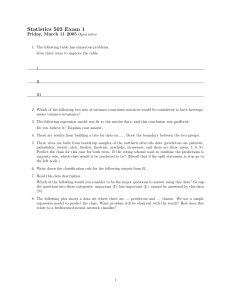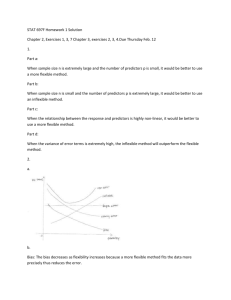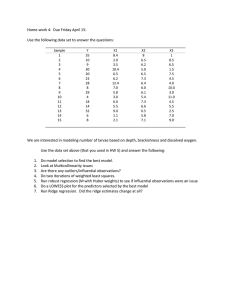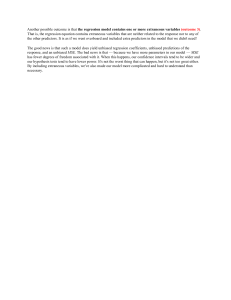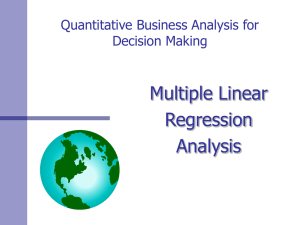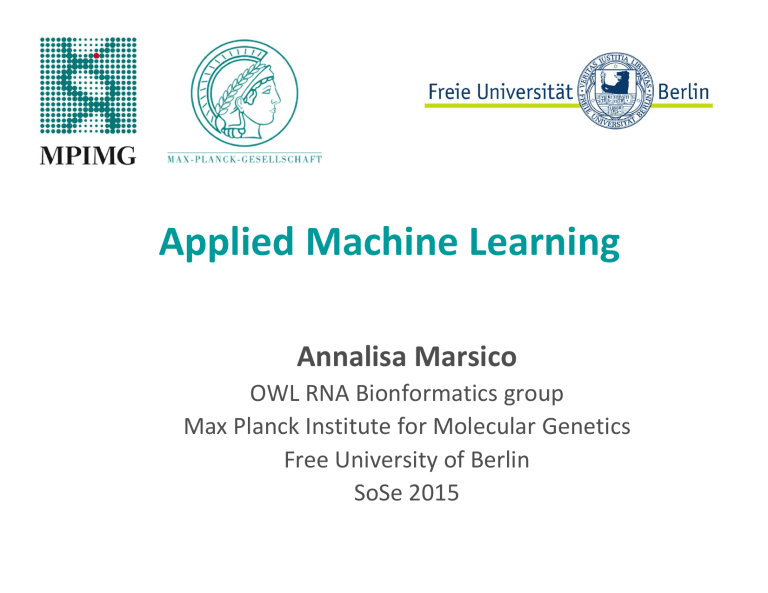
Applied Machine Learning
Annalisa Marsico
OWL RNA Bionformatics group
Max Planck Institute for Molecular Genetics
Free University of Berlin
SoSe 2015
What is Machine Learning?
What is Machine Learning?
The field of Machine Learning seeks to answer the question:
“How can we build computer systems that automatically improves with experience,
and what are the fundamental laws that govern all learning processes?”
Arthur Samuel (1959): field of study that gives computers the ability to learn
without being explicitly programmed
– ex: playing checkers against Samuel,
the computer eventually became much better than Samuel
– this was the first solid refutation
to the claim that computers cannot learn
What is Machine Learning?
Tom Mitchell (1998): a computer learns from experience E
with respect to some task T and some performance
measure P, if its performance on T as measured by P
improves with E
What is Machine Learning?
Computer ML
Statistics
Science
How can we build machines
that solve problems and which problems
are tractable/intractable?
What can be inferred from the data plus
some modeling assumptions, with what
reliability?
ML‘s applications
– Army, security
– imaging: object/face detection and recognition, object traking
– mobility: robotics, action learning, automatic driving
– Computers, internet
– interfaces: brainwaves (for the disable), handwriting / speech recognition
– security: spam / virus filtering, virus troubleshooting
ML‘s applications
– Finance
– banking: identify good, dissatisfied or prospective customers
– optimize / minimize credit risk
– market analysis
– Gaming
– intelligent: adaptibility to the player, agents
– object tracking, 3D modeling, etc...
ML‘s applications
– Biomedicine, biometrics
– medicine: screening, diagnosis and prognosis, drug discovery etc..
– security: face recognition, signature, fingerprint, iris verification etc..
– Bioinformatics
– motif finder, gene detectors, interaction networks, gene expression
predictors, cancer/disease classification, protein folding prediction, etc..
Examples of Learning problems
• Predict whether a patient, hospitalized due to a heart attack, will
have a seocnd heart attack, based on diet, blood tests, diesease
history..
• Identify the risk factor for colon cancer, based on gene expression
and clinical measurements.
• Predict if an e-mail is spam or not based on most commonly
occurring words (email/spam -> classification problem)
• Predict the price of a stock in 6 months from now, based on
company performance and economic data
You already use it! Some more
examples from daily life..
• Based on past choices, which movies will interest this viewer?
(Netflix)
• Based on past choices and metadata which music this user will
probably like? (Lastfm, Spotify)
• Based on past choices and profile features should we match these
people in online dating service (Tinder)
• Based on previous purchases, which shoes is the user likely to like?
(Zalando)
However, predictive models regularly generate wrong predicitons:
In 2010 an errouneous algorithm has caused a finantial crash..
Learning process
• Predictive modeling: process of developing a
mathematical tool or model that generates
accurate predictions
Prediction vs Interpretation
• It is always a trade-off
• If the goal is high accuracy (e.g. Spam filter) then we
do not care ‚why‘ and ‚how‘ the model reaches it
• If the goal is interpretability (e.g. In Biology, SNPs
which predict a certian disease risk) then we care
‚why‘ and ‚how‘
Key ingredients for a successful
predictive model
• Deep knowledge of the context and the problem
– If a signal is present in the data you are gonna find it
– Choose your features carefully (e.g. collect relevant
data)
• Versatile computational toolbox for model
building, but also data pre-processing,
visualization, statistics
– Weka, Knime, R (check out caret package)
• Critical evaluation
Supervised vs Unsupervised Learning
Typical Scenario
We have an outcome quantitative (price of a stock, risk factor..) or
categorical (heart attack yes or no) that we want to predict based on some
features. We have a training set of data and build a prediction model, a
learner, able to predict the outcome of new unseen objects
- A good learner accurately predicts such an outcome
- Supervised learning: the presence of the outcome variable is guiding the
learning process
- Unsupervised learning: we have only features, no outcome
- Task is rather to describe the data
Unsupervised learning
• find a structure in the data
• Given X ={xn} measurements / obervations /features
find a model M such that p(M|X) is maximized
i.e. Find the process that is most likely to have generate the data
Supervised learning
Find the connection between two sets of observations: the input
set, and the output set
– given {xn , yn}, find an hypothesis f (function, classification boundary)
, such that ∀n ∈ [1..N], N number of observations, f(xn ) = yn
X={xn} also called predictors, independent variables or covariates
Y={yn} also called response, dependent variable
Example1: Colorectal Cancer
There is a correlation between CSA (colon specific antigen) and a number of
clinical measuremnets in 200 patients.
Goal: predict CSA from clinical measurements
Supervised learning
Regression problem (outcome measure is quantitative)
Example2: Gene expression
microarrays
Measure the expression of all genes in a cell simultaneously,
by measuring the amount of RNA present in the cell for
that gene. We do this for several experiments (samples).
Goal: understand how genes and samples are organized
- Which genes are predictive for certain samples?
Unsupervised learning: p (# of samples) << N (# of genes)
Supervised learning: yes, possible, with some tricks
Variable Types
• Y quantitative -> regression model
Y qualitative (categorical) -> classification model (two or more classes)
• Inputs X can also be quantitative or qualitative
• there can be missing values
• dummy variable sometime a convenient way
• Both problems can be viewed as a task in function approximation f(X)
Let‘s re-formulate the training task
• Given X (features), make a good prediction of Y,
denoted by Ŷ (i.e. Identify appropriate function f(X)
to model Y). If Y takes values in R, then so should Ŷ
(quantitative response). For categorical output Ĝ
should take a class value, as G (categorical response).
Supervised Linear Models
Linear Models and Least Square
Given a vector of inputs X X 1 , X 2 ,.... X p
p = # of features; N = # of points,
we want to predict the output Y via the model:
T
p
Unknown coefficients
parameters of the model
Yˆ f ( X ) ˆ0 X j ˆ j
j 1
or
Yˆ X T ˆ
N.B we have included β0 in the coefficient vector
Matrix notation
For each point i, i=1....N
y i 0 1 x i1 2 x i 2 ....... p x ip
Linear Models and Least Square
We want to fit a linear model to a set
of training data {(xi1...xip), yi}. There might be several choices of β.
How do we choose them?
Linear Models and Least Square
• Least square method: we pick the coefficients β to minimize the
residual sum of squares
2
p
N
2
T
RSS ( ) yi f ( xi ) yi 0 xij j yi xi
i 1
i 1
j 1
i 1
N
N
2
The solution is easy to characterize
If we write it in matrix notation
RSS ( ) (Y X )T (Y X )
X T (Y X ) 0
ˆ ( X T X ) 1 X T Y
differentiation
with respect to β
One feature
What happens if p > N? I.e. XTX is singular?
two features
Another geometrical interpretation of
linear regression
Least-square regression with two predictors. The outcome vector y is orthogonally
projected into the hyperplane spanned by input vectors x1 and x2. The projection
^y represents the vector of the least square prediction.
2
We minimize RSS ( ) y X by choosing β so that the residual vector is orthogonal
to this subspace.
Example: Quantitative StructureActivity Relationship
We want to study the relationship between chemical structure and activity (solubility)
Screen several compounds against a target in a biolgical assay
Measure quantitative features xj (molecular weight,
electrical charge, surface area, # of atoms..)
The response y is the activity (inibition, solubility..)
yi 0 1 xi1 2 xi 2 ... p xip
Quantitative structure-activity relationship (QSAR modeling)
Aspirin
Measuring Performance in Regression
Models
If the outcome is a number -> RMSE (function of the model residuals)
RMSE
1
N
N
2
ˆ
(
y
y
)
i i
i 1
real value
predicted value
Another measure is R2 -> proportion of information in the data which is explained
by the model. More a measure of correlation
A short de-tour of the Predictive
Modeling Process
Always do a scatter plot of response vs each feature to see if a linear relationship
exists!
Introduce some
Non-linearity into the model
y 0 1x1 2 x12
Fit to local linear regression
A short de-tour of the Predictive
Modeling Process
„How“ the predictors enter the model is very important:
1. Data transformation
1. Centering / scaling
2. data skewed
3. Outliers
2. feature engineering / feature extraction
1. What are actually the informative features?
A short de-tour of the Predictive
Modeling Process
Data transformation
Necessary to avoid biases
Z
xx
mean of the data - centering
standard deviation - scaling
Skewness
x x
3
i
s
i
( n 1)v 3 / 2
x x
2
i
v
i
n 1
A value s of 20 indicates
high skewness. Log transformation
helps reducing the skewness
Between-Predictor Correlations
Predictors can be correlated. If correlation among predictors is high, then the
Ordinary least square solution for linear regression will have high variability
and will be unstable -> poor interpretation
Correlation heatmap for the structure-solubility data
Collinearity: high correlation between pairs of variables
Data reduction and feature extraction
We want to have a smaller set of predictors which captures most of the
Information in the data -> maybe predictors which are combinations of
the original predictors?
Principal Component Analysis (PCA)
is a commonly used data reduction technique
A short de-tour of the Predictive
Modeling Process
Data reduction and feature extraction
What about removing correlated predictors?
Yes, possible, but there are cases where a predictor is correlated to a
Linear combination of other predictors..Not detectable with correlation analysis
Other reasons to remove predictors:
1. Zero variance predictors (variables with few unique values)
2. Frequency of unique values is severely disproportioned
Goal: We want a technique (regression)
which takes into account (solves)
correlated variables..
Regression + feature reduction
Principal Component Analysis (PCA)
Idea:
• Given data points (predictors) in d-dimensional space,
project into lower dimensional space while preserving as
much information as possible
– E.g. Find best planar approximation to 3D data
• Learns lower dimensional representation of inputs
• Underlines structure in the data
• It generates a smaller set of predictors which captures the
majority of the information in the original variables
• New predictors are functions of the original predictors
Example 1: study the motion of a spring
• The important dimension to describe the dynamics
of the system is x – but we do not know that!
• Every time sample recorded by the cameras is a point
(vector) in a D-dimensional space, D=6
• Form linear algebra: every vector in a D-dimensional space
can be written as linear combination of some basis
• Is there other basis (linear combination of original basis) which better
re-expresses the data?
Principal Component Analysis (PCA)
The hope is that the new basis will filter out the noise and reveal the hidden
structure of the data -> In my case they will determine x as the important
direction..
You may have noticed the use of the word linear: PCA makes the stringent
but powerful assumption of linearity -> restricts the set of potential bases
PCA – formal definition
• PCA: orthogonal projection of the data into a
lower dimensional space, such as the variance
of the projected data is maximum
Variance and the goal
Quantitatively we assume that directions with largest variances in
our data space contain the dynamics of interest and so highest SNR
Principal Component analysis
y
x
Geometrical interpretation: find the rotation of the basis (axes) in a way that the first axis lies
in the direction of greatest variation. In the new system the predictors (PCs) are orthogonal
PCA - Redundancy
When two predictors x1 and x2 are correlated (measure redundant information),
this will complicate the effect of x1 and x2 on the response. It seems that either one
predictor or a linear combination of predictors can be used here
PCA in words
– Find the linear combination of X (in the new basis) which has the
maximum variation
– How do we formally find these new directions (basis) ui?
– Project data on new directions XTu
– Find u1 such that var(XTu1) is maximized subjected to the condition u1Tu1=1
– Find u2 such that var(XTu2) is maximized subjected to the condition u2Tu2=1
and u1Tu2=0
– Keep finding direction of greatest variation orthogonal to those already found
– Ideally, if N is the dimensionality of original data, we need only few D < N
directions to explain sufficiently the variability in the data
How many Principal
Components?
• Use the eigenvalues, which represent the variance explained by each component
• Choose the number of eigenvalues that amount to the desired percentage of the
variance
Scree plot
PCA example: image compression
Principal Component Analysis (PCA)
PCs are surrogate features / variables and therefore (linear) functions of the
original variables which better re-express the data
Then we can express the PCs as linear combinations of the original predictors.
The first PC is the best linear combination – the one capturing most of the variance
PC j a j1 feature 1 a j 2 feature 2 ... a jp featurep
p = # of predictors
aj1, aj2,.... ajp component weights / loadings
Summarizing..
The cool thing is that we have create components PCs which are uncorrelated
Some predictive models prefer predictors which are uncorrelated in order
To find a good solution. PCA creates new predictors with such characteristics!
To get an intuition of the data:
If the PCA captured most of the
information in the data, then plotting
E.g. PC1 vs PC2 can reveal clusters/structures
In the data
PCA – practical hints
1. PCA seeks direction of maximum variance, so it is sensitive to the
scale of the data, it might give higher weights to variables
on ‚large‘ scales.
Good practise is re-scale the data before doing PCA
2. Skeweness can also cause problems
Goal: We want a technique (regression)
which takes into account (solves)
correlated variables..
Regression + feature reduction
But PCA is an unsupervised technique..so it is blind to the response
Principal Component Regression (PCR)
Dimension reduction method: it works in two steps
1. Find transformed predictors Z1, Z2, ..Zm with m < p (# of original features)
2. Fit a least square model to these new predictors
p
M
Z m a jm X j
yi 0 m Z im
m 1
j 1
Fitting a regression
model to Zm
The choise of Z1...Zm and the selection of ajm can be achieved in different ways
One way is Principal Component Regression (PCR) – almost PLS..
E.g.
Z1 a11 x1 a21 x2
First principal components in the case of two variables
scores or loadings
Drawback of PCR
We assume that the direction in which xi show the most variation are the
directions associated to the reponse y..
If this assumption holds, then an appropriate choice of M = # of components
will give better results.
But this assumption is not always fullfilled and when Z1..Zm are produced in
an unsupervised way there is no garantee that these directions (which best
explain the input) are also the best to explain the output.
When will PCR perform worse than normal least square regression?
Partial Least Square Regression (PLSR)
• Supervised alternative to PCR. It makes use of the response Y to identify
the new features
• attempts to find directions that help explaining both the response and the
predictors
PLS Algorithm
1. Compute first partial least square direction Z1
by setting aj1 in the formula to the coefficients
from simple linear regression of Y onto Xj
p
p
Z m a jm X j
Z1 a j1 X j
j 1
j 1
2. Different intepretation of the loading ajm : here, how
much the predictor is important for the reponse!
3. Then Y is regressed on Z1, giving θ1
4. To find Z2 we ‚adjust‘ all variables for Z1. Means we project
or regress them to Z1
ˆ
X j j Z1
5. Compute the residuals (the remaining information which has not been explained
by the first PLS)
X Z
j
j
1
6. Compute Z2 (Zm) in the same way, using the projected data
7. The iterative approach can be repeated M times to identify multiple PLS comp
Example from the QSAR modeling
problem - PCR
Scatter plot of two predictors
Direction of the first PC
The first PC direction contains no
predictive information of the response
Example from the QSAR modeling
problem - PLS
PLS direction on two predictors
PLS direction contains highly
predictive information of the response
Example from the QSAR modeling
problem – PCR & PLS
Compaison of PLS and PCR
Summary
• Dimension reduction (PCA)
• Regression problem
– Linear regression (least-square)
– PCR and PLS are methods for feature reduction
and de-correlation of the features
Improves over-fitting, accuracy, can be hard to
interpret
